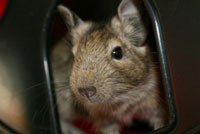|
|
|
Degus Care Sheet |
| |
 |
| |
 Degus (pronounced day-goo) are small (approx. 6
inches in length plus another 6 inches of tail,
weighing about 1/2 a pound), rodent-like animals
from South America and are closely related to
the chinchilla. They look rather like large
gerbils, although, degus are not actually
rodents at all. They are more closely related to
rabbits than gerbils. Degus (pronounced day-goo) are small (approx. 6
inches in length plus another 6 inches of tail,
weighing about 1/2 a pound), rodent-like animals
from South America and are closely related to
the chinchilla. They look rather like large
gerbils, although, degus are not actually
rodents at all. They are more closely related to
rabbits than gerbils. |
| |
|
Degus come from the lowland, west coast plains
of Chile and up through the Andes Mountains.
They live in large social colonies much like
prairie dogs and they nest and store food under
rocks or hedges. |
| |
|
Degus can live to be around 15 years old in the
wild, but in captivity their life span is often
shortened to about10-12 years because it is hard
to replicate their specialized diet of bulbs,
twigs, etc. Degus are also prone to cataracts
and mouth diseases. Degus are Durarial. They are
awake all day but they take naps throughout the
day, they play with each other, and they like to
dig. Degus are more vocal, though, rather like
guinea pigs. They make a variety of noises
including weeping, warbling with happiness, and
shrieking when alarmed. Keep your Degu at room
temperatures.Kept in an
area that is free of drafts and direct sunlight.
They are most comfortable at temperatures of
between 65-80 degrees Fahrenheit. (18-27 degrees
Celsius) The basic rule of thumb is, if you are
comfortable without a sweater, they will do just
fine. |
| |
|
Housing
- We
recommend keeping degus in pairs, as degus are
highly social animals. For a pair you can also
use those large wire cages with ramps often used
for chinchillas and ferrets. You should include
a water bottle and a food dish. For bedding, use
Carefresh or some other non toxic litter, Aspen
Shaving work well. You can give the degus
cardboard boxes to hide in with tissue paper to
make a nest with. Things to chew on like toilet
paper rolls are fun to play with and keep their
teeth worn down. They chew chew chew! Bird toys
work wonders. If the cage is large enough, you
can put some non-toxic branches for them to run
around on. You can also supply them with a
tail-safe wheel to run on. Degus have very
fragile tails, you can't pick them up by it like
you can with gerbils. A degu has the ability to
shed its tail much like a lizards, but a degu's
doesn't grow back. |
| |
|
Feeding and Health - Degus have slightly more specialized diets than
other common pets firstly because they can't
digest sugars. Their species has developed in a
part of the world where their foods do not
usually contain sugars, and so their bodies have
evolved and can not digest the sugar because
they've never needed to. They can become
diabetic if fed too many sugars, which
eventually leads to cataracts. We recommend
feeding a Degu diet along with hay. An
occasional treat could be pieces of sweet
potatoes, a few sunflower seeds, or peanut.
Don't give your degus any fruit (or else very
minimal amounts) or any other sugar-holding
treats. Try to avoid starchy foods also. Some
people just stick with the mix and hay diet and
don't give treats. Whatever works for you is
fine as long as the degu is kept healthy. |
| |
|
Degus are also prone to mouth diseases, their
water should be changed daily or at least every
couple of days. |
| |
|
Your
degu's teeth should be an orange-yellow color,
not white. If they are white, he is probably
very sick. The coloration is due to the fact
that the chlorophyll in the greens that they eat
reacts with an enzyme in their bodies and
produces an orange organic fluid in their
saliva. |
| |
|
Grooming -
Degus benefit from a weekly bath in chinchilla
dust just like chinchillas do. Simply put some
of the dust in a wide dish and let them roll
around in it, and their fur and skin will be
much healthier and cleaner. |
| |
|
Sexing and Breeding
-
Deciding the sexes of degus is much harder than
other rodents. The most distinguishing
characteristic is the spacing between the
urethra and the anus. In the female, the urethra
and anus are very close together, while in the
male a bit of space can be seen between these
openings. In mature animals, the male urethra
takes on more of a penile shape, while the
female urethra is more conical. Female Degus are
usually larger than male ones. Degus become
sexually mature at the age of 6-9 months,
although there have been reported cases of 8-9
week old females being impregnated. Degus have a
fairly long gestation period - about 90 days -
and the young are born fully furred and with
their eyes open. The average litter size is 5 or
6. Both parents help care for the young. Degu
pups stop nursing at around 4 weeks, and can
usually be safely weaned at 5 or 6 weeks old. |
| |
|
Degus, like gerbils, have a post-partum estrus,
which means they can mate as soon as they give
birth. If they do not mate at that time, they
will probably not come into estrus again until
they have weaned the litter |
| |
|
|
|
|